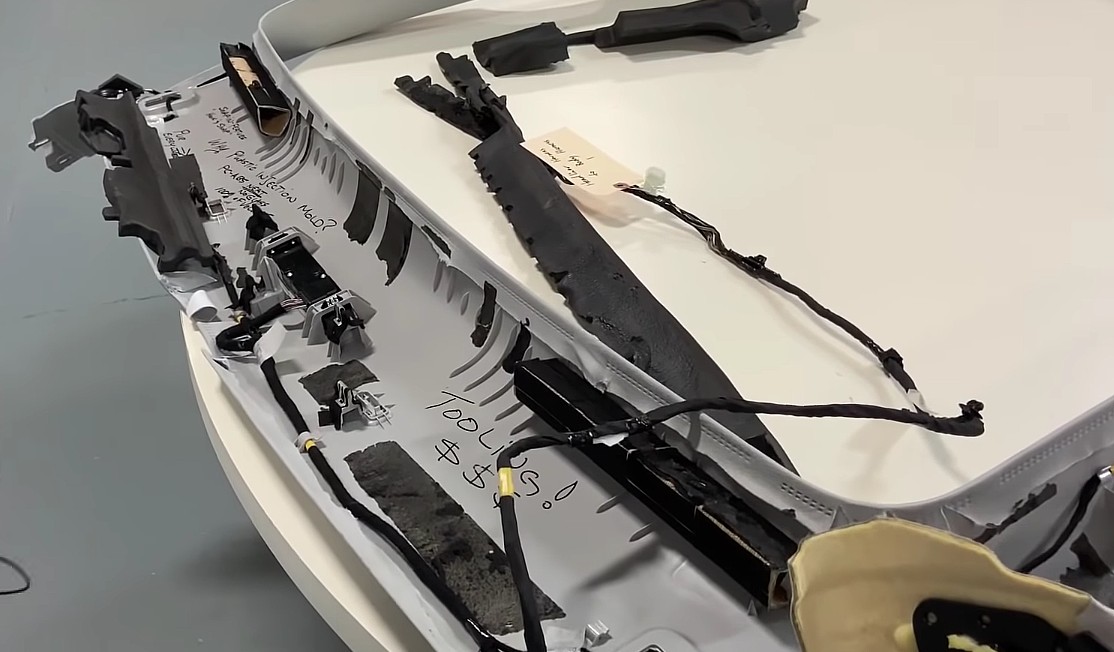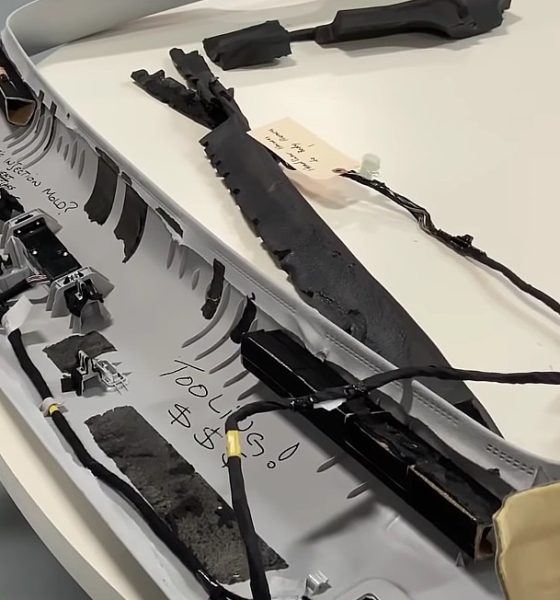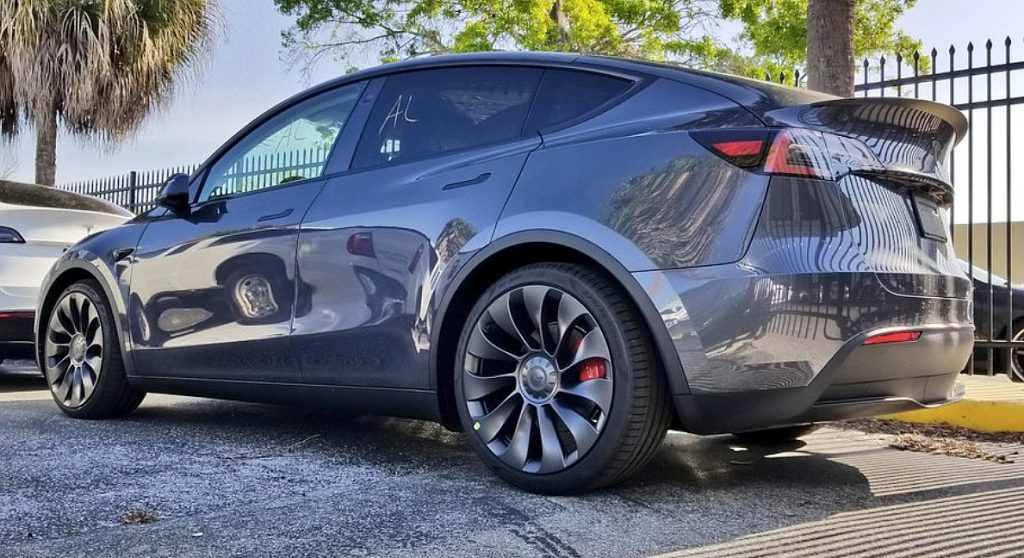

News
Tesla’s sure-footed Model Y approach is the crossover market’s ultimate Trojan Horse
The future of the crossover market may have already started changing–the auto industry has just not realized it yet. Signs of this shift could be found beneath the surface of the Tesla Model Y, a crossover that represents the years of experience in vehicle making that the Silicon Valley-based company gained since it started building cars over a decade ago.
The Model Y could almost be described as Tesla’s most unassuming vehicle based on its exterior. Featuring a very similar design as the Model 3 and lacking the flashy features of the Model X, the Model Y looks very understated. This is one of the reasons why it was so easy for critics to dismiss the Model Y. Some, on account of the crossover’s Model 3-based design during its unveiling, even flat-out insisted that the Model Y does not exist.
The Model Y is currently undergoing a thorough teardown and analysis from automotive specialist Sandy Munro of Munro and Associates. The progress of the Model Y teardown has been incremental due to the ongoing pandemic, but the sections of the vehicle that have already undergone analysis all show one theme: the Model Y is the representation of Tesla’s refinements to its vehicle production process over the years, regardless of how minor they might be.
This could be seen in a comparison of the Model Y and the Model 3’s headliner. A look at the first-production Model 3’s headliner shows that Tesla seemed to have gone for a more traditional approach for the component, such as using glue to set specific parts in position. Tesla used a more unique injection-molded headliner for the Model Y, which eliminates the need for much of the glue used in the Model 3’s component. A hefty dose of Noise, Vibration, and Harshness (NVH) countermeasures were also found on the crossover. Overall, the Model Y shows a far more sure-footed Tesla, one that has solid experience in carmaking.

Elon Musk has noted on Twitter that teardown experts like Munro will likely find many pleasant surprises in the Model Y, and so far, this does seem to be the case. While the vehicle still has areas for improvement, the fact remains that the crossover, which is still in its first production, is already far more refined than its predecessor. From its novel Octovalve system to its use of rigid wiring that can be set by robots on a fully-automated line, the Model Y seems to be Tesla’s most forward-thinking vehicle yet. And this could make all the difference.
The Model Y is competing in the crossover segment, which is highly competitive but incredibly lucrative. Just like the pickup truck market, there are vehicles that have become legends in the crossover industry, from affordable entries such as the Toyota RAV4 to premium SUVs like the Porsche Macan. The Model Y is designed to compete in this market and offer potential customers a compelling alternative to tried and tested vehicles. Considering its price, its tech, and the fact that it seems to be designed very well, the Model Y will likely have more than a fighting chance to compete.
Tesla has a habit of making a vehicle that ends up becoming a Trojan horse of sorts. The Model 3 is one of these, as the car ended up disrupting the midsize premium sedan market to such a degree that sales of rivals like the BMW M3 have been decimated, despite critics largely dismissing Tesla in the lead up to its release. But unlike the Model 3’s first production units, even the Model Y’s first run already shows a certain degree of maturity in vehicle design and manufacturing. The Model Y will only get better with time as Tesla continues to refine little aspects of the vehicle, but even at its current state, the all-electric crossover is already something that is out of the ordinary.
And that is the biggest irony of all. Legacy automakers appear to have adopted a pretty dismissive approach to the Model Y. Save for Ford, which has unveiled the Mustang Mach-E, and Porsche, which has announced an all-electric Macan, the premium all-electric crossover market seems strangely open for domination. Just like with the Model 3, legacy auto appears to be all-too-willing to make way for the Model Y. And just as before, by the time competitors realize the all-electric crossover’s true potential, there is a very good chance that they will be late, just as the Model 3’s rivals like the BMW i4 are late today.

News
Tesla (TSLA) receives “Buy” rating and $551 PT from Canaccord Genuity
He also maintained a “Buy” rating for TSLA stock over the company’s improving long-term outlook, which is driven by autonomy and robotics.

Canaccord Genuity analyst George Gianarikas raised his Tesla (NASDAQ:TSLA) price target from $482 to $551. He also maintained a “Buy” rating for TSLA stock over the company’s improving long-term outlook, which is driven by autonomy and robotics.
The analyst’s updated note
Gianarikas lowered his 4Q25 delivery estimates but pointed to several positive factors in the Tesla story. He noted that EV adoption in emerging markets is gaining pace, and progress in FSD and the Robotaxi rollout in 2026 represent major upside drivers. Further progress in the Optimus program next year could also add more momentum for the electric vehicle maker.
“Overall, yes, 4Q25 delivery expectations are being revised lower. However, the reset in the US EV market is laying the groundwork for a more durable and attractive long-term demand environment.
“At the same time, EV penetration in emerging markets is accelerating, reinforcing Tesla’s potential multi‑year growth runway beyond the US. Global progress in FSD and the anticipated rollout of a larger robotaxi fleet in 2026 are increasingly important components of the Tesla equity story and could provide sentiment tailwinds,” the analyst wrote.
Tesla’s busy 2026
The upcoming year would be a busy one for Tesla, considering the company’s plans and targets. The autonomous two-seat Cybercab has been confirmed to start production sometime in Q2 2026, as per Elon Musk during the 2025 Annual Shareholder Meeting.
Apart from this, Tesla is also expected to unveil the next-generation Roadster on April 1, 2026. Tesla is also expected to start high-volume production of the Tesla Semi in Nevada next year.
Apart from vehicle launches, Tesla has expressed its intentions to significantly ramp the rollout of FSD to several regions worldwide, such as Europe. Plans are also underway to launch more Robotaxi networks in several more key areas across the United States.
News
Waymo sues Santa Monica over order to halt overnight charging sessions
In its complaint, Waymo argued that its self-driving cars’ operations do not constitute a public nuisance, and compliance with the city’s order would cause the company irreparable harm.

Waymo has filed a lawsuit against the City of Santa Monica in Los Angeles County Superior Court, seeking to block an order that requires the company to cease overnight charging at two facilities.
In its complaint, Waymo argued that its self-driving cars’ operations do not constitute a public nuisance, and compliance with the city’s order would cause the company irreparable harm.
Nuisance claims
As noted in a report from the Los Angeles Times, Waymo’s two charging sites at Euclid Street and Broadway have operated for about a year, supporting the company’s growing fleet with round-the-clock activity. Unfortunately, this has also resulted in residents in the area reportedly being unable to sleep due to incessant beeping from self-driving taxis that are moving in and out of the charging stations around the clock.
Frustrated residents have protested against the Waymos by blocking the vehicles’ paths, placing cones, and “stacking” cars to create backups. This has also resulted in multiple calls to the police.
Last month, the city issued an order to Waymo and its charging partner, Voltera, to cease overnight operations at the charging locations, stating that the self-driving vehicles’ activities at night were a public nuisance. A December 15 meeting yielded no agreement on mitigations like software rerouting. Waymo proposed changes, but the city reportedly insisted that nothing would satisfy the irate residents.
“We are disappointed that the City has chosen an adversarial path over a collaborative one. The City’s position has been to insist that no actions taken or proposed by Waymo would satisfy the complaining neighbors and therefore must be deemed insufficient,” a Waymo spokesperson stated.
Waymo pushes back
In its legal complaint, Waymo stated that its “activities at the Broadway Facilities do not constitute a public nuisance.” The company also noted that it “faces imminent and irreparable harm to its operations, employees, and customers” from the city’s order. The suit also stated that the city was fully aware that the Voltera charging sites would be operating around the clock to support Waymo’s self-driving taxis.
The company highlighted over one million trips in Santa Monica since launch, with more than 50,000 rides starting or ending there in November alone. Waymo also criticized the city for adopting a contentious strategy against businesses.
“The City of Santa Monica’s recent actions are inconsistent with its stated goal of attracting investment. At a time when the City faces a serious fiscal crisis, officials are choosing to obstruct properly permitted investment rather than fostering a ‘ready for business’ environment,” Waymo stated.
News
Tesla FSD v14.2.2 is getting rave reviews from drivers
So far, early testers have reported buttery-smooth drives with confident performance, even at night or on twisty roads.

Tesla Full Self-Driving (Supervised) v14.2.2 is receiving positive reviews from owners, with several drivers praising the build’s lack of hesitation during lane changes and its smoother decision-making, among others.
The update, which started rolling out on Monday, also adds features like dynamic arrival pin adjustment. So far, early testers have reported buttery-smooth drives with confident performance, even at night or on twisty roads.
Owners highlight major improvements
Longtime Tesla owner and FSD user @BLKMDL3 shared a detailed 10-hour impression of FSD v14.2.2, noting that the system exhibited “zero lane change hesitation” and “extremely refined” lane choices. He praised Mad Max mode’s performance, stellar parking in locations including ticket dispensers, and impressive canyon runs even in dark conditions.
Fellow FSD user Dan Burkland reported an hour of FSD v14.2.2’s nighttime driving with “zero hesitations” and “buttery smooth” confidence reminiscent of Robotaxi rides in areas such as Austin, Texas. Veteran FSD user Whole Mars Catalog also demonstrated voice navigation via Grok, while Tesla owner Devin Olsen completed a nearly two-hour drive with FSD v14.2.2 in heavy traffic and rain with strong performance.
Closer to unsupervised
FSD has been receiving rave reviews, even from Tesla’s competitors. Xpeng CEO He Xiaopeng, for one, offered fresh praise for FSD v14.2 after visiting Silicon Valley. Following extended test drives of Tesla vehicles running the latest FSD software, He stated that the system has made major strides, reinforcing his view that Tesla’s approach to autonomy is indeed the proper path towards autonomy.
According to He, Tesla’s FSD has evolved from a smooth Level 2 advanced driver assistance system into what he described as a “near-Level 4” experience in terms of capabilities. While acknowledging that areas of improvement are still present, the Xpeng CEO stated that FSD’s current iteration significantly surpasses last year’s capabilities. He also reiterated his belief that Tesla’s strategy of using the same autonomous software and hardware architecture across private vehicles and robotaxis is the right long-term approach, as it would allow users to bypass intermediate autonomy stages and move closer to Level 4 functionality.








